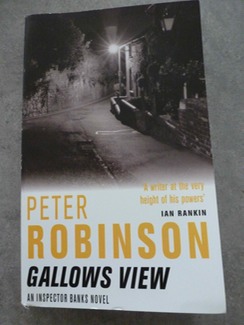
Given the number of Peter Robinson titles sitting on the shelves he’s always been a candidate for a read them in sequence operation, so I’ve been watching the el cheapo bins for a while, and with the early titles pretty well covered early 2013 seemed like a good time to start on the time trip back through the Chief Inspector Banks series.
The interesting part in such exercises is always checking how fully formed the characters are from the get-go, and how subsequent developments and long term players are brought into play.
Six months after his relocation from London, Banks, his wife and two kids are, on the surface, pretty comfortably settled into the new surroundings. Sandra mightn’t be overly happy about the change, but has her interest in photography to keep her going, and it’s an interest that contributes to one of the plot lines, and the two kids seem fairly contented, or as contented as the teenage offspring of a policeman who works long and irregular hours can be expected to be.
Which leaves Banks, still finding his way in his new station while a peeping tom sets about spreading alarm through the women of Eastvale, a series of break and enters keeps the constabulary busy and the death of an elderly woman needs to be investigated because it could be murder.
There’s every chance these three strands are going to end up intertwined, and, of course, they are, since two of them tie into the street that gives the novel its name.
Along the way we’re introduced to the two young thugs who are responsible for the break-ins, as well as the young, attractive female psychologist who is recruited to assist in building a personality profile of the surreptitious voyeur. There is, after all, the possibility that his activities may escalate beyond just looking, and given the demands of their respective jobs Banks and Jenny Fuller meet to discuss these matters over a jar or two in the evenings, a situation you might suspect is likely to escalate into intimacy (and it’s not as if Banks isn’t tempted) that also contributes to the way things shake out in the end.
Right from the start Chief Inspector Banks comes across as an intriguing character, perceptive, innately curious and displaying a degree of compassion you might have expected a stint in the city to knock out of him. Perhaps it was the fear of such a development that prompted his move to the Yorkshire Dales in search of a quieter lifestyle.
Having arrived there and settled in, the wave of break and enters are a pain in the neck, though Banks picks (correctly) a couple of likely suspects fairly easily, but the peeping tom is creating issues with the local feminists, who allege police insensitivity to the issue means they’re not pursuing the peeper as vigorously as they might. That, in turn explains the decision to bring the feminist psychologist into the equation.
The burglaries may have escalated into murder when the body of 87-year-old Alice Matlock is found in her home, which has been ransacked. The problem there is that there’s a concurrent sighting of the peeper in the same vicinity, which poses an interesting bracket of questions that need answers.
As it turns out there’s another explanation for Alice’s death, which wasn’t caused by an escalation of the peeper’s intent or a burglary gone wrong, but finding the explanation requires an escalation of the peeper’s intent and a burglary that turns into rape and provides the key that unlocks the whole tangled tale.
The book itself, first published as far back as 1987, is fairly obviously a first effort in a planned series, with things being set in place for sequels, with some fairly obvious generic elements but there’s a sense of place and the characters work fairly well. Banks is a likeable character, the dialogue is tight and believable and while you could pick on a number of cliches there’s obviously enough potential there for the author to keep going and the reader to stay involved.